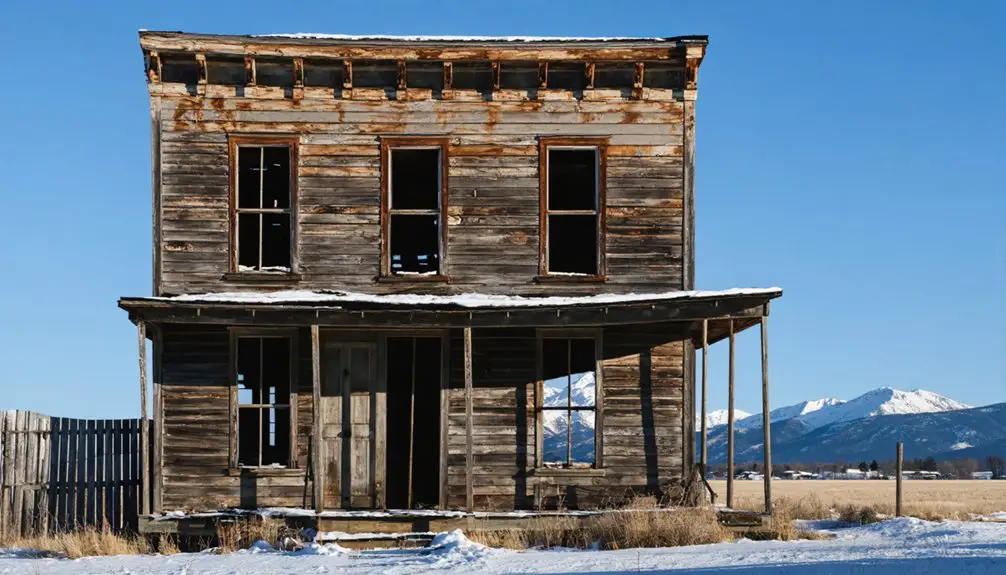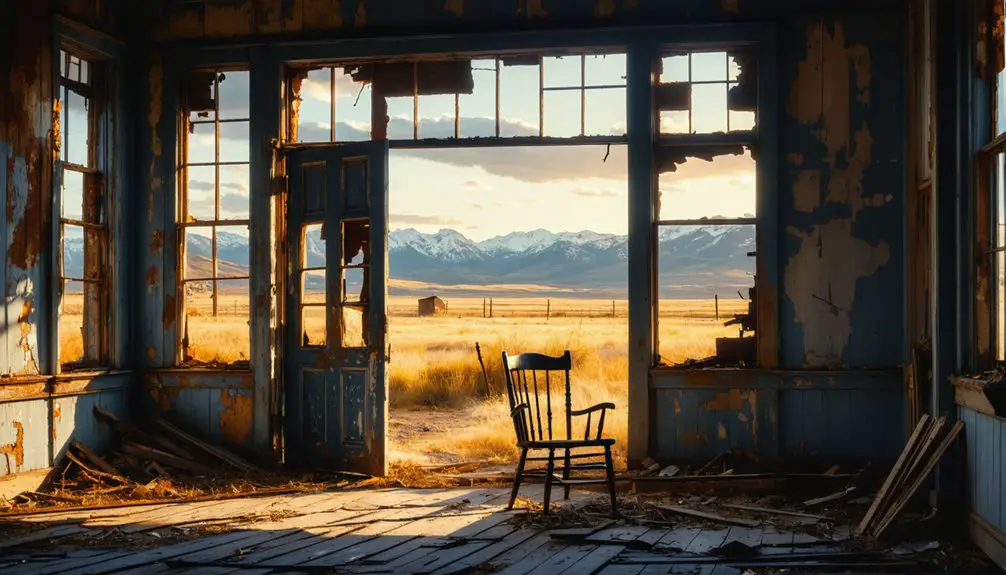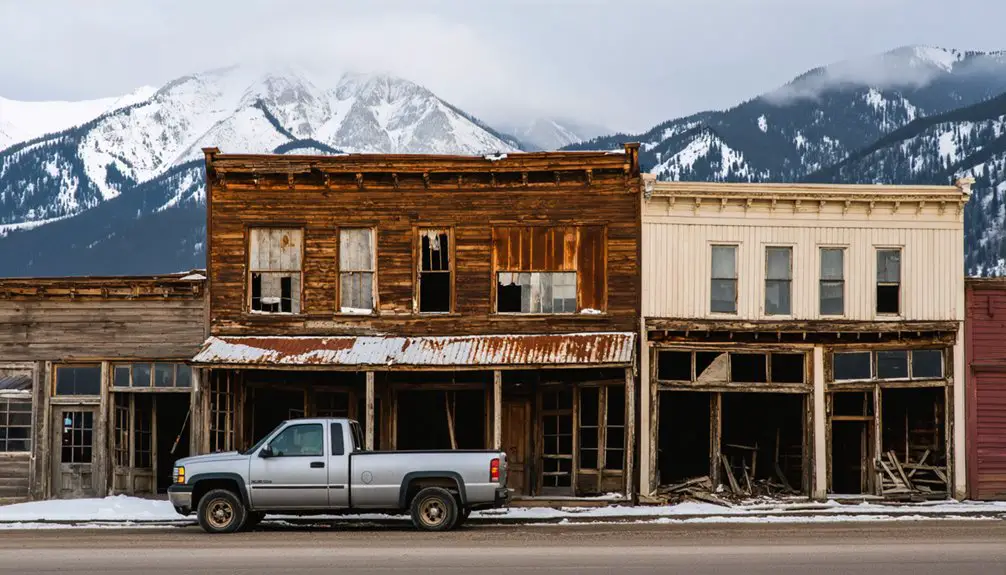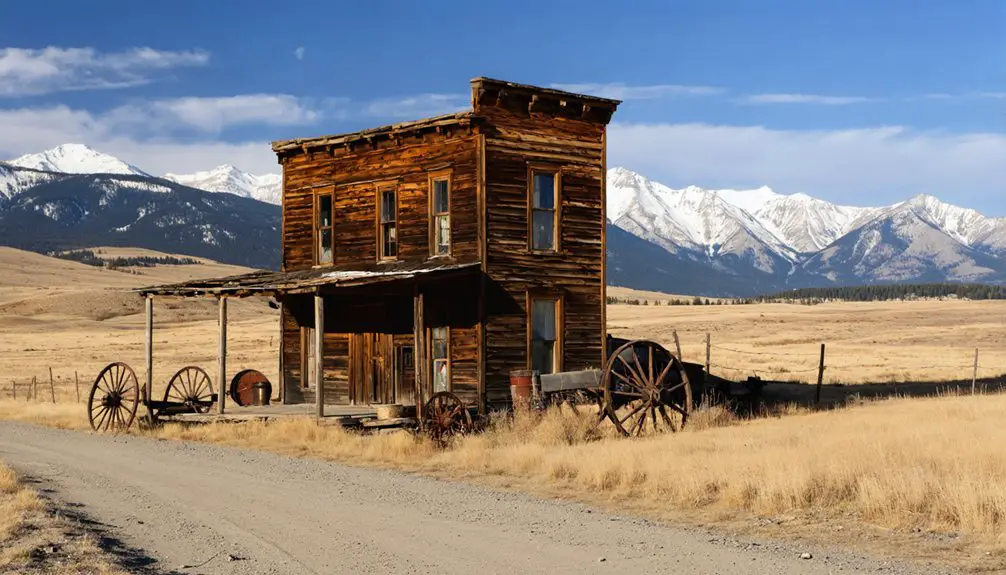You’ll find Elkhorn Ghost Town nestled in Montana’s Elkhorn Mountains, where Swiss immigrant Peter Wyes first discovered silver in 1870. This remarkably preserved 1880s mining town once bustled with 2,500 residents during its peak silver production years. Today, you can explore two protected landmarks in Montana’s smallest state park – Fraternity Hall and Gillian Hall – along with original log cabins and a historic water tower. The site’s rich history holds tales of prosperity, epidemics, and mysterious deaths.
Key Takeaways
- Elkhorn is Montana’s smallest state park, featuring preserved Fraternity Hall and Gillian Hall as remnants of a once-thriving 1880s silver mining town.
- The town peaked at 2,500 residents during the silver boom, producing 8.9 million ounces of silver before declining due to falling prices.
- A devastating diphtheria epidemic in 1888-1889 contributed to the town’s decline, causing significant loss of life among children and families.
- Original structures including the Water Tower and pre-1892 buildings still stand, showcasing authentic frontier architecture and mining-era construction.
- The ghost town became largely abandoned by the 1970s and now offers visitors an authentic Old West experience without modern amenities.
The Silver Discovery That Started It All
A single discovery in the Elkhorn Mountains of Montana sparked what would become one of the territory’s most productive silver mining operations.
You’ll find the roots of this mining legacy in 1870, when Swiss immigrant Peter Wyes stumbled upon rich silver veins in the hills above what’s now Elkhorn, Montana.
Though Wyes wouldn’t live to see the fruits of his silver discovery, dying mysteriously by 1872, his find laid the groundwork for decades of prosperous mining.
In 1875, prominent Helena businessman Anton M. Holter purchased Wyes’ claim, transforming it into the Holter Lode – Elkhorn’s first major mine.
The booming town soon featured various retail stores and amenities to serve the growing population.
This development triggered a rush of mining activity, bringing additional operations like the C&D, Golden Curry, Hard Cash, and Union mines to the area. The town’s population grew rapidly, reaching about 2,500 residents during its peak in the late 1880s.
Life in a Victorian-Era Mining Town
While silver discoveries brought fortune-seekers to Elkhorn, daily life in this Victorian-era mining town reflected the era’s distinct blend of frontier ruggedness and period refinement.
You’d find Victorian architecture ranging from simple wooden miners’ cabins to more ornate homes of successful mine owners, with false-front commercial buildings lining the dirt streets.
The demanding mining labor shaped daily rhythms, as workers headed underground before dawn for backbreaking shifts.
Between the physical toil, you’d find community life centered around saloons, churches, and community halls where residents gathered.
Local merchants and craftsmen kept the town running, while hotels housed the steady stream of prospectors and visitors.
Despite harsh conditions and limited medical care, seasonal celebrations and entertainment like musical shows helped maintain social bonds in this isolated mountain community.
Much like Virginia City’s Victorian Ball, annual events and festivals brought townspeople together for moments of refined social interaction.
The town’s rich placer diggings in nearby gulches ensured a steady flow of gold that supported the growing community throughout the 1860s.
The Unique Social Character of Elkhorn
Unlike typical mining camps dominated by single men, Elkhorn stood out as a remarkably refined and family-oriented community where married miners raised their children alongside craftsmen, merchants, and woodsmen.
The town reached its peak with a population of 2,500 during the silver mining boom years.
During lean mining times, many residents sustained themselves through timber cutting activities.
Strong family bonds shaped daily life, with nearly 200 students attending three schools and families gathering at social hubs across town.
You’d find a vibrant social scene where residents came together at these notable spots:
- Fraternity Hall – the heart of community life hosting dances, concerts, and theater
- Hoffman’s Barbershop – the town’s only bathing facility due to water scarcity
- Ford’s Candy Store – a sweet escape from the mining life
- Two-lane bowling alley – a unique recreational feature for an isolated mining town
Even through hardships like the devastating diphtheria epidemic, social gatherings and community spirit persisted, defining Elkhorn’s distinctive character.
Peak Years of Silver Production
You’ll find that Elkhorn’s peak silver production in the late 1880s relied heavily on advanced stamp mills and chloridizing methods to process high-grade ore.
The mine’s modernization under the Elkhorn Mining Company transformed operations, expanding from a 10-stamp mill to a 25-stamp facility with new smelters built in 1884-85.
This industrialization paid off tremendously, as the mine produced an impressive 8.9 million ounces of silver by 1900, generating approximately $30,000 per month during peak operations.
Production Methods and Technology
As Elkhorn’s silver mining operations expanded in the 1870s and 1880s, production methods evolved from basic extraction to sophisticated processing systems.
You’ll find the mining techniques advanced rapidly as shaft depths reached beyond 800 feet, requiring new hoisting and ventilation systems to access deeper ore bodies. The region’s mines struggled to maintain profitability as rich silver zones were rarely found below 1,000 feet depth. By 1922, the site operated at reduced capacity with poor transportation costs hindering operations.
The progression of ore processing technology included:
- Initial 5-stamp mill with limited capacity for early shallow mining
- Upgraded 10-chloridizing mill processing 11 tons daily
- Expansion to 25 stamps by 1888, marking peak operations
- Addition of a smelter in 1885 for refining ore concentrates
The site’s infrastructure grew to include extensive milling facilities, with later operations incorporating zinc recovery and tailings reprocessing through the mid-1900s using evolving chemical treatment methods.
Economic Impact and Growth
During the peak years of silver production, Elkhorn Mine emerged as one of Montana’s most significant mining operations, yielding an impressive 8.9 million ounces of silver, 8,500 ounces of gold, and over 4 million pounds of lead by 1900.
Despite mining investments of $5 million, the operation’s total revenue reached only $375,000 by 1949.
However, you’ll find the mine’s broader economic impact was substantial. The district generated $23 million in mineral production at its height, employing 250 men and supporting a bustling town of 2,500 residents.
Local infrastructure expanded rapidly as the workforce grew, including 1,500 mules and 500 woodsmen supporting daily operations.
The mine’s success attracted outside investors in 1883, leading to technological improvements like a 10-stamp chloridizing mill that enhanced silver recovery.
Architecture and Notable Buildings

While many mining ghost towns have crumbled into obscurity, Elkhorn’s architectural legacy lives on through its two most prominent structures – Fraternity Hall and Gillian Hall.
These preserved buildings showcase classic American frontier architecture and now form Montana’s smallest state park. Since 1980, preservation techniques have protected these wooden landmarks against harsh mountain elements.
Montana’s tiniest state park preserves two frontier-era wooden buildings, standing testament to mining history despite brutal mountain weather.
As you explore Elkhorn’s architecture, you’ll discover:
- A downstairs social hall where miners once danced and celebrated
- Original log cabins with mysterious cellars dating before 1892
- The historic Water Tower, recently preserved as a symbol of mining infrastructure
- A pre-1892 butcher’s residence that still stands on private land
The town’s buildings reflect practical frontier design, built primarily from local materials with an emphasis on function over decoration.
The Devastating Diphtheria Epidemic
During the harsh winter of 1888-1889, you’d find Elkhorn in the grip of a devastating diphtheria epidemic that claimed the lives of many residents, with a shocking mortality rate of around 20%.
In one particularly tragic week, a single family lost seven members to the disease, highlighting the epidemic’s ruthless spread through the close-knit mining community of 2,500.
The epidemic’s impact on Elkhorn’s children left a somber legacy visible in the town’s cemetery, where rows of small graves from this period stand as silent witnesses to the community’s darkest chapter.
Disease Strikes The Town
As Elkhorn reached its peak population of 2,500 residents in the late 1880s, a devastating diphtheria epidemic struck the town between 1888 and 1889, claiming numerous lives and forever altering its trajectory.
The epidemic response included school closures, though mining operations continued despite the outbreak’s severity.
You’ll find the human toll was particularly devastating for these reasons:
- The disease mainly targeted children and women, with a death rate of about 20%
- Multiple family members often died within the same week
- Harsh winter conditions of 1888-1889 intensified the outbreak’s spread
- Limited medical options existed in the remote mining town
The community resilience was tested as the chiefly immigrant families faced both the deadly outbreak and the beginning of economic challenges that would eventually lead to the town’s decline.
Children Bear Heavy Toll
The devastating diphtheria epidemic of 1888-1889 struck Elkhorn’s children with particular ferocity, claiming young lives at an alarming rate of 20%.
You’ll find evidence of this tragic child mortality in Elkhorn Cemetery, where headstones mark siblings who died within days of each other during the outbreak.
The epidemic’s impact rippled through the community, forcing school closures and halting social gatherings. Families endured profound grief as they lost multiple children in quick succession.
In the cramped quarters of this mining town, the disease spread rapidly, especially during the harsh winter months. The community’s isolation and lack of modern medical facilities left parents with few treatment options.
This period of intense community grief contributed greatly to Elkhorn’s eventual decline, leaving a lasting legacy of sorrow that echoes through time.
Community’s Lasting Impact
Beyond the immediate toll of lost lives, Elkhorn’s diphtheria epidemic fundamentally reshaped the town’s social fabric and economic destiny. The outbreak’s ripple effects compounded existing challenges from plummeting silver prices, accelerating the once-thriving community’s decline.
Despite harsh conditions, you’ll find evidence of remarkable community resilience in how residents banded together:
- Fraternity Hall became a crucial gathering space for mutual support and maintaining social bonds.
- Local institutions like churches coordinated care efforts despite limited medical resources.
- The cemetery stands as a powerful symbol of cultural memory, documenting shared tragedy.
- Community bonds strengthened through collective hardship at social centers.
This devastating chapter ultimately contributed to Elkhorn’s shift from bustling silver town to ghost town, permanently altering Montana’s mining heritage.
Economic Challenges and Population Decline
Despite Elkhorn’s initial prosperity from silver mining, economic challenges and public health crises devastated the town’s future by the turn of the 20th century.
The town’s economic fragility became evident when silver prices plummeted, causing the once-profitable Elkhorn Mine to struggle with reduced operations and eventual shutdowns. Monthly ore yields that had reached $30,000 in the 1880s dwindled dramatically.
Once a silver mining powerhouse generating $30,000 monthly, Elkhorn Mine crumbled as plummeting silver prices forced operations to halt.
A devastating diphtheria epidemic struck simultaneously, killing many children and testing community resilience. The combined impact of economic hardship and disease accelerated Elkhorn’s decline.
The population, which peaked at 2,500 in the late 1880s, steadily decreased as families left to seek opportunities elsewhere. By the 1970s, Elkhorn had transformed from a bustling mining town into a ghost town, preserved today as a state park.
Tales of Mystery and Local Legends

Following Elkhorn’s economic downfall and population exodus, ghostly tales and local legends emerged to fill the haunting silence of this once-vibrant mining town.
You’ll find a rich tapestry of haunting legends woven through Elkhorn’s abandoned structures and weathered gravesites, particularly centered around the devastating diphtheria epidemic of 1888-1889.
- Shadowy figures drift near crumbling buildings, while unexplained footsteps echo through the old hotel.
- The mountain cemetery, where epidemic victims rest, harbors cold spots and mysterious lights.
- Fraternity Hall and Gillian Hall pulse with residual energy from their glory days.
- The former doctor’s office and collapsed homes fuel stories of restless spirits.
These ghostly sightings, documented by paranormal investigators and visitors alike, paint Elkhorn as more than just another abandoned mining town.
Preservation Efforts and State Park Status
When you visit Elkhorn State Park today, you’ll find Montana’s smallest state park focused on preserving two key historic buildings: Fraternity Hall and Gillian Hall.
These unrenovated structures have been carefully maintained since the park’s establishment in 1980, allowing visitors to experience authentic frontier architecture from the town’s silver mining heyday.
Tourism has played a crucial role in supporting preservation efforts, with the Historic American Buildings Survey documenting these structures to guarantee their lasting protection for future generations.
Historic Buildings Maintained Today
While Elkhorn’s mining heyday has long passed, two remarkable buildings stand as monuments to Montana’s frontier era: Fraternity Hall and Gillian Hall.
These architectural treasures, protected within Elkhorn State Park since 1980, showcase authentic late 1800s frontier craftsmanship through historic preservation efforts.
When you visit these meticulously maintained structures, you’ll discover:
- Original fixtures and structural elements that transport you to the silver mining boom
- Second-floor access in Fraternity Hall where social gatherings once thrived
- Authentic interiors that housed everything from lively dances to prizefights
- Educational displays and interpretive signage revealing the town’s vibrant past
The Western Montana Ghost Town Preservation Society continues to protect these buildings, ensuring they remain structurally sound while retaining their genuine historic character.
Tourism Impact Since 1980
The 1980 designation of Elkhorn as Montana’s smallest state park marked a turning point in the town’s preservation story. You’ll find the site continues to draw visitors fascinated by its authentic ghost town atmosphere and mining heritage, though tourist numbers remain modest due to its remote location and minimal facilities.
Today’s visitor motivations center on experiencing frontier architecture, exploring mining history, and capturing photographs of this well-preserved slice of the Old West.
Tourist demographics include historians, photographers, and outdoor enthusiasts seeking an authentic ghost town experience. The presence of a few permanent residents and restored cabins adds a unique living-history dimension to your visit.
While the park’s small footprint limits large-scale tourism infrastructure, it’s successfully preserved the site’s historic character while maintaining public access.
Modern-Day Ghost Town Experience

Located about 18 miles from Boulder, Montana, Elkhorn offers visitors an uncommonly authentic ghost town exploration that stands apart from typical tourist destinations.
You’ll find preserved structures like Fraternity Hall alongside naturally deteriorating buildings, creating a rare glimpse into over a century of undisturbed decay.
Your historical reflection begins as you encounter:
- Original community halls in various states of preservation
- A historic cemetery with graves from the 1888-1889 diphtheria epidemic
- The doctor’s office and other standing structures from the silver mining era
- Private residences that remain partially occupied, marking boundaries between past and present
You’ll need to plan ahead as there aren’t modern amenities, but this rawness contributes to Elkhorn’s unique atmosphere of solitude and genuine historical immersion.
Frequently Asked Questions
What Was the Average Wage of Miners in Elkhorn During Peak Operations?
While you might expect precise figures, you can’t pinpoint exact mining wages, but during peak 1880s-1890s operations, you’d likely have earned $2-4 daily, plus potential stock options based on regional norms.
Were There Any Documented Paranormal Activities in Elkhorn’s Abandoned Buildings?
You won’t find reliable documentation of ghost sightings or haunted buildings in historical records. While some YouTube videos claim paranormal activity, there’s no scientifically verified evidence of supernatural phenomena there.
How Did Residents Survive the Harsh Montana Winters in Elkhorn?
You’d survive winter by relying on log cabins with wood stoves, preserved food stockpiles, warm wool clothing, and community resources. Sharing supplies and gathering in communal buildings helped everyone endure harsh conditions.
What Happened to the Mining Equipment After the Town’s Abandonment?
You’ll find most mining equipment was left to decay after town abandonment in the 1970s. It’s still there, rusting away as historical artifacts in Montana’s smallest state park.
Did Any Famous Outlaws or Historical Figures Ever Visit Elkhorn?
You won’t find outlaw encounters or visits from famous historical figures in Elkhorn’s records. The town’s immigrant families and mining entrepreneurs kept the community focused on business rather than attracting notorious characters.
References
- https://www.atlasobscura.com/places/elkhorn-ghost-town
- https://passionsandplaces.com/elkhorn-montana-ghost-town/
- https://www.youtube.com/watch?v=J38tAc_Z5rw
- https://en.wikipedia.org/wiki/Elkhorn
- https://www.legendsofamerica.com/mt-elkhorn/
- https://yesterdaystrails.wordpress.com/2020/08/27/gt002-silver-mining-ghost-town-of-elkhorn-montana-1955/
- https://westernmininghistory.com/towns/montana/elkhorn/
- https://southwestmt.com/blog/elkhorn-montanas-smallest-state-park/
- https://www.bigskymontananet.com/history_museums/virginia_city.php
- https://virginiacitymt.com/Experience-The-Old-West/index



